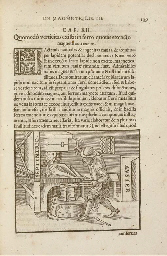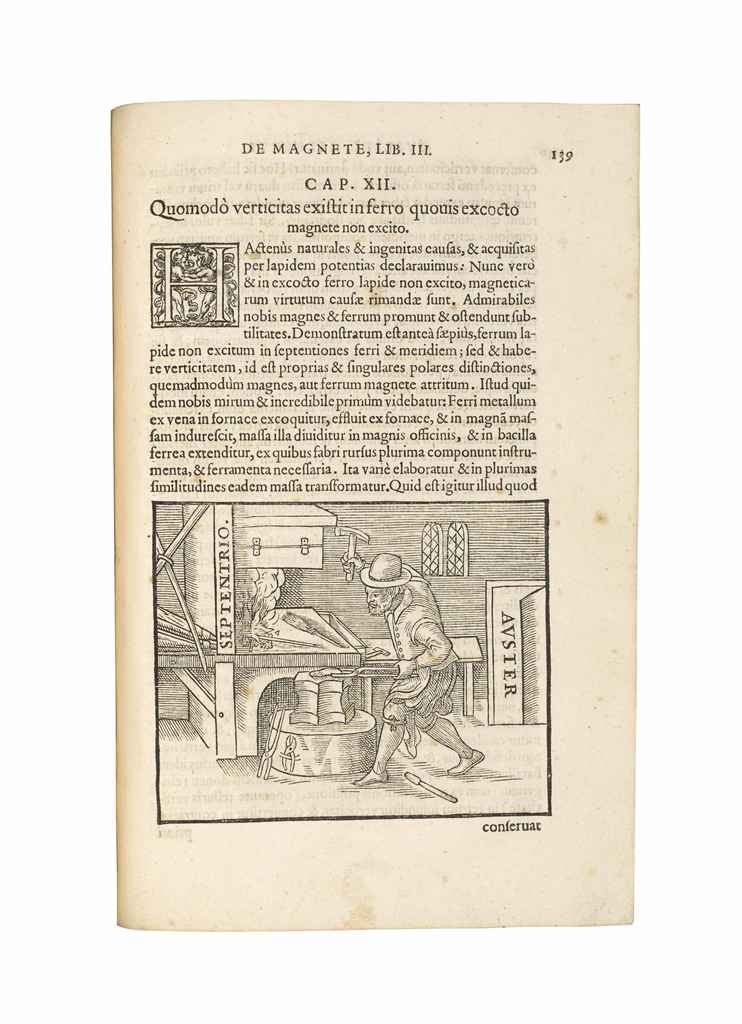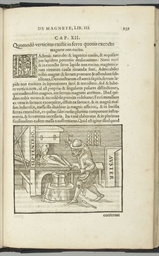GILBERT, William (1544-1603). De magnete, magneticisque corporibus, et de magno magnete tellure; Physiologia nova, plurimis & argumentis, & experimentis demonstrata . London: Peter Short, 1600. First edition of the first great scientific book printed in England . ‘Gilbert coined the terms "electricity", "electric force" and "electric attraction" and may rightly be considered the founder of electrical science' (PMM); further, he ‘provided the only fully developed theory dealing with all five of the then known magnetic movements and the first comprehensive discussion of magnetism since the thirteenth-century Letter on the Magnet of Peter Peregrinus’ (DSB). De magnete exemplifies pre-Baconian experimental philosophy by supporting new theories with empirically-derived experimental evidence, and these experiments were described in sufficient detail for the reader to recreate them. Gilbert also described his scientific instruments in great detail, including new ones such as the ‘versorium’: the first instrument to be used for the study of electric phenomena. Gilbert observed that the earth was a gigantic magnet and provided a physical basis for the Copernican theory. His work was cited by Digby, Boyle, Kepler and Huygens, and Galileo drew on Gilbertian magnetism to support his belief in a Copernican heliocentric cosmology in his Dialogo . Dibner Herald s 54; Grolier Science 41; Norman 905; PMM 107; Wellcome 2830. Folio (270 x 180mm). Woodcut title device and large woodcut arms on verso, one folding plate, 87 woodcuts in text of which 4 full-page, decorative woodcut initials and head- and tailpieces (a little soiling to the title, first and last leaf lightly browned, a few occasional scattered rust spots). 19th-century quarter calf, sides covered with black marbled paper, flat spine filleted and lettered in gilt (spine worn, extremities rubbed). Provenance : Jesuit Collège Royal Henry-Le-Grand, La Flèche, France (17th-c. inscriptions on title) – Jesuit residence in Laval, France (stamp on title, ticket on front paste-down) – Jesuit Maison Saint-Louis, Jersey, Channel Islands (stamp on the titlepage).
GILBERT, William (1544-1603). De magnete, magneticisque corporibus, et de magno magnete tellure; Physiologia nova, plurimis & argumentis, & experimentis demonstrata . London: Peter Short, 1600. First edition of the first great scientific book printed in England . ‘Gilbert coined the terms "electricity", "electric force" and "electric attraction" and may rightly be considered the founder of electrical science' (PMM); further, he ‘provided the only fully developed theory dealing with all five of the then known magnetic movements and the first comprehensive discussion of magnetism since the thirteenth-century Letter on the Magnet of Peter Peregrinus’ (DSB). De magnete exemplifies pre-Baconian experimental philosophy by supporting new theories with empirically-derived experimental evidence, and these experiments were described in sufficient detail for the reader to recreate them. Gilbert also described his scientific instruments in great detail, including new ones such as the ‘versorium’: the first instrument to be used for the study of electric phenomena. Gilbert observed that the earth was a gigantic magnet and provided a physical basis for the Copernican theory. His work was cited by Digby, Boyle, Kepler and Huygens, and Galileo drew on Gilbertian magnetism to support his belief in a Copernican heliocentric cosmology in his Dialogo . Dibner Herald s 54; Grolier Science 41; Norman 905; PMM 107; Wellcome 2830. Folio (270 x 180mm). Woodcut title device and large woodcut arms on verso, one folding plate, 87 woodcuts in text of which 4 full-page, decorative woodcut initials and head- and tailpieces (a little soiling to the title, first and last leaf lightly browned, a few occasional scattered rust spots). 19th-century quarter calf, sides covered with black marbled paper, flat spine filleted and lettered in gilt (spine worn, extremities rubbed). Provenance : Jesuit Collège Royal Henry-Le-Grand, La Flèche, France (17th-c. inscriptions on title) – Jesuit residence in Laval, France (stamp on title, ticket on front paste-down) – Jesuit Maison Saint-Louis, Jersey, Channel Islands (stamp on the titlepage).





.jpg)



.jpg)

.jpg?height=400)


Testen Sie LotSearch und seine Premium-Features 7 Tage - ohne Kosten!
Lassen Sie sich automatisch über neue Objekte in kommenden Auktionen benachrichtigen.
Suchauftrag anlegen